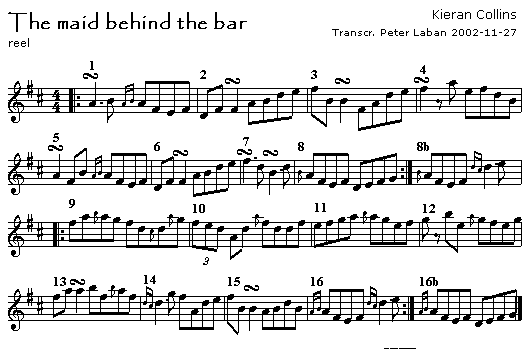A brief analysis by Peter Laban, 27 November 2002

From a recording by Kieran Collins from the 1970s. The tune is played as the second tune in a set of two reels, the first is Last Night's Fun. A transcription of that tune is published here as well. The maid behind the bar is an extremely popular and much hackneyed tune. Much of its present popularity goes back to a version recorded during the 1970s by Stockton's Wing. The tune has been recorded though right from the early era of 78 rpms, a nice version by piper Tom Ennis is just one example. O'Neill published it in his collection as The green mountain, a name now more commonly attached to a close variant of the tune.
Collins, with a great eye for detail and with much personal flair, manages to make the so often tired-sounding tune sound almost completely fresh. It speaks well for the ability of any musician to take such an overplayed tune and give it a new lease of life.
Bar 1 The long roll on A gives the tune a great flowing opening. He then doesn't opt for the AF~F2, a route some players may take but plays AFEF instead giving the melody just that extra bit of drive.
He follows that nicely by dropping below the common version inBar 2. with DF~F2
Bar 3-4 The tune flows along in fine style
andBar 5 receives a fine twist when the long roll of the opening bar is not repeated but instead becomes a short roll followed by FB leading up to the next movement
Bar 7is another example of the lovely flow Collins manages to give the tune, here by very stylishly using two long rolls before decending to the end of the part.
The second part starts of very much in the standard way, Bar 10 brings a few nice touches the fed triplet followed by a drop to A in the lower octave
Bar 11bring an example of melodic compression where Collins avoids a high B and instead plays two a s separate by a cut, a device that can add an impression of drive to a melody
He immediately follows this by a nice break in the rhythm when taking a breather inbar 12 bar 14 sees the introduction of quite an unexpected movement when he follows the long d by g fadf a movement not often used by whistlers, but one common among pipers maybe a touch of influence of the likes of Seamus Ennis or Tommy Reck.
This is what I thought I heard.
Peter Laban, 27 November 2002